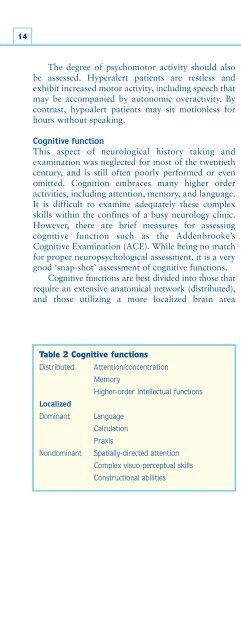Create successful ePaper yourself
Turn your PDF publications into a flip-book with our unique Google optimized e-Paper software.
14The degree of psychomotor activity should alsobe assessed. Hyperalert patients are restless andexhibit increased motor activity, including speech thatmay be accompanied by autonomic overactivity. Bycontrast, hypoalert patients may sit motionless forhours without speaking.Cognitive functionThis aspect of neurological history taking andexamination was neglected for most of the twentiethcentury, and is still often poorly performed or evenomitted. Cognition embraces many higher orderactivities, including attention, memory, and language.It is difficult to examine adequately these complexskills within the confines of a busy neurology clinic.However, there are brief measures for assessingcognitive function such as the Addenbrooke’sCognitive Examination (ACE). While being no matchfor proper neuropsychological assessment, it is a verygood ‘snap-shot’ assessment of cognitive functions.Cognitive functions are best divided into those thatrequire an extensive anatomical network (distributed),and those utilizing a more localized brain area(localized) (Table 2). Impairment of a distributedfunction, such as attention, does not allow the clinicianto localize the lesion, but suggests that there is a deficitsomewhere in the network subserving attention, whichcan then be further localized with subsequent examinationand investigation. By contrast, a deficit in a localizedfunction such as language allows the lesion site tobe pinpointed from history and examination alone.Distributed cognitive functionsAttention/concentrationAttention is difficult to define, but impliesconcentration and persistence. Impaired attentionimplies inability to focus and selectively concentrateon a topic, with impersistence, distractibility, andoften disorientation, e.g. as seen in the acuteconfusional state. Anatomically, attention requires adistributed system including neocortex (especiallyprefrontal), thalamus, and brainstem, linked by thereticular activating system (6). Attention may bedisrupted by any focal lesion affecting this distributedsystem, or by a diffuse disturbance, such as metabolicupset or the effect of drugs.Table 2 Cognitive functionsDistributed Attention/concentrationMemoryHigher-order intellectual functionsLocalizedDominant LanguageCalculationPraxisNondominant Spatially-directed attentionComplex visuo-perceptual skillsConstructional abilities6Cortical areasPre-frontal, posterior parietal,and ventral temporalThalamusIntralaminar and reticular nucleiDopaminergic, cholinergic, andserotinergic pathwaysBrainstemnucleiReticular formation, midlineraphe, locus coeruleus, andtegmental nuclei6 Schematic diagram to show the anatomy of the reticularactivating system.
















